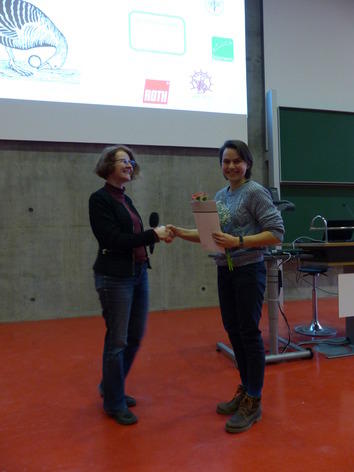Lara S. Burchardt

Communication and Cognition in Bats (Knörnschild Lab)
Institute of Biology
Freie Universität Berlin
Ph.D. Candidate (Elsa-Neumann Scholarship)
Rhythm, Biomusicality, Song, Echolocation

Student talk price 2018: 13th Annual Meeting of the Ethological Society, Potsdam, Germany.
Picture credit: Gabriele J. Kowalski
How rhythmic are animal vocalizations?
Music is one of the few behaviors that clearly separates us from our closest relatives. The question of the evolution of music remains unanswered. As opposed to the cultural phenomenon 'music', the basis for the construct ‘music’ can be described as 'musicality'. Honing et al. (2015) define musicality as 'a natural, spontaneously developing trait based on and constrained by biology and cognition'. Their idea is to study music by examining the musicality of different animal species. Musical could for example be an animal's response to pitch ratios or the temporal structure of conspecific vocalizations (for a review, see Hoeschele et al. 2015).
Rhythm is a key component of many different forms of music and can be investigated in animal vocalizations in different ways. Several important questions regarding rhythm in animal vocalizations exist: How stereotyped are rhythms in one individual, vocalization type, social group or even species? How good are animals in producing those rhythms?
Studies on rhythm in animal vocalizations are still scarce but cover a wide range of taxa. For instance, male zebra finch song has an individually distinct isochronous pulse (Norton & Scharff 2016), palm cockatoos use tools to ‘drum’ an isochronous beat on branches in a consistent context (Heinsohn et al. 2017), and male Northern Elephant Seals discriminate between familiar and unfamiliar male opponents using the temporal structure of vocalizations (Mathevon et al. 2017).
My thesis aims to investigate the temporal structure of animal vocalization on different levels, namely on the individual level, vocalization type level, and group level. I will analyze vocalizations of animals from different taxa, all sharing the ability to produce vocalizations while moving. I hope to get insights into the relationship between functional rhythms such as a wingbeat and the temporal structure of vocalizations. Species of interest are bats as well as baleen whales (since both taxa sing during locomotion) and toothed whales (since both taxa echolocate and vocalize during locomotion). Also of interest are birds, in particular species with extensive flight song such as skylarks.
With my dissertation project, I hope to broaden the knowledge on temporal structures in animal vocalizations. Specifically, I want to find out whether reoccurring temporal patterns can be found in individuals or groups, how close to a ‘perfect rhythm’ those are and which biological constraints might have shaped them.
Heinsohn R, Zdenek CN, Cunningham RB, Endler JA, Langmore NE (2017) Tool-assisted rhythmic drumming in palm cockatoos shares key elements of human instrumental music. Science Advances: 3(6),e1602399.
Hoeschele, M, Merchant H, Kikuchi Y, Hattori Y, ten Cate C (2015). Searching for the origins of musicality across species. Philosophical Transactions of the Royal Society B: 370,1664.
Honing H, ten Cate C, Peretz I, Trehub SE (2015) Without it no music: cognition, biology and evolution of musicality. Philosophical Transactions of the Royal Society B: 370,1664.
Mathevon N, Casey C, Reichmuth C, Charrier I (2017) Northern Elephant Seals Memorize the Rhythm and Timbre of Their Rivals Voices. Current Biology: 27(15),2352-2356.
Norton P, Scharff C (2016) “Bird Song Metronomics": Isochronous Organization of Zebra Finch Song Rhythm. Frontiers in Neuroscience: 10,309.
[2] Jin EJ, Kiral FR, Ozel MN, Burchardt LS, Osterland M, Epstein D, Wolfenberg H, Prohaska S, Hiesinger PR (2018). Live Observation of Two Parallel Membrane Degradation Pathways at Axon Terminals. Current Biology. Online first.
[1] Hu C, Petersen M, Hoyer N, Spitzweck B, Tenedini F, Wang D, Gruschka A., Burchardt LS, Szpotowicz E, Schweizer M, Guntur A, Yang CH, Soba P (2017) Sensory integration and neuromodulatory feedback facilitate Drosophila mechanonociceptive behavior. Nature Neuroscience 20(8):1085-1095.
